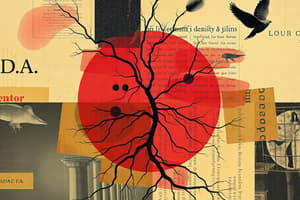Podcast
Questions and Answers
Which type of nerve endings are dendrites whose terminal ends have little or no physical specialization?
Which type of nerve endings are dendrites whose terminal ends have little or no physical specialization?
- Interoceptors
- Unencapsulated nerve endings (correct)
- Special sense organs
- Encapsulated nerve endings
Which type of nerve endings are dendrites whose terminal ends are enclosed in a capsule of connective tissues?
Which type of nerve endings are dendrites whose terminal ends are enclosed in a capsule of connective tissues?
- Interoceptors
- Unencapsulated nerve endings
- Special sense organs
- Encapsulated nerve endings (correct)
Which type of sense organs consist of sensory neurons with receptors for the special senses (vision, hearing and equilibrium, smell, taste) together with connective, epithelial, or other tissues?
Which type of sense organs consist of sensory neurons with receptors for the special senses (vision, hearing and equilibrium, smell, taste) together with connective, epithelial, or other tissues?
- Encapsulated nerve endings
- Special sense organs (correct)
- Interoceptors
- Unencapsulated nerve endings
Which type of receptors occur at or near the surface of the skin and are sensitive to stimuli occurring outside or on the surface of the body?
Which type of receptors occur at or near the surface of the skin and are sensitive to stimuli occurring outside or on the surface of the body?
Which type of receptors respond to stimuli occurring in the body from visceral organs and blood vessels?
Which type of receptors respond to stimuli occurring in the body from visceral organs and blood vessels?
Which type of receptors respond to physical force such as pressure and stretch?
Which type of receptors respond to physical force such as pressure and stretch?
Which type of receptors respond to light?
Which type of receptors respond to light?
Which type of receptors respond to temperature changes?
Which type of receptors respond to temperature changes?
Which type of receptors respond to dissolved chemicals during sensation of taste and smell and to changes in internal body chemistry?
Which type of receptors respond to dissolved chemicals during sensation of taste and smell and to changes in internal body chemistry?
Flashcards are hidden until you start studying
Study Notes
Types of Nerve Endings
- Free nerve endings are dendrites with little or no physical specialization at their terminal ends.
- Encapsulated nerve endings are dendrites with terminal ends enclosed in a capsule of connective tissue.
Sense Organs
- Special sense organs consist of sensory neurons with receptors for vision, hearing, equilibrium, smell, and taste, along with connective, epithelial, or other tissues.
Receptors
- Exteroceptors occur at or near the surface of the skin and respond to external stimuli or stimuli on the surface of the body.
- Interoceptors respond to stimuli occurring in the body from visceral organs and blood vessels.
- Mechanoreceptors respond to physical forces such as pressure and stretch.
- Photoreceptors respond to light.
- Thermoreceptors respond to temperature changes.
- Chemoreceptors respond to dissolved chemicals during sensation of taste and smell, as well as changes in internal body chemistry.
Studying That Suits You
Use AI to generate personalized quizzes and flashcards to suit your learning preferences.




